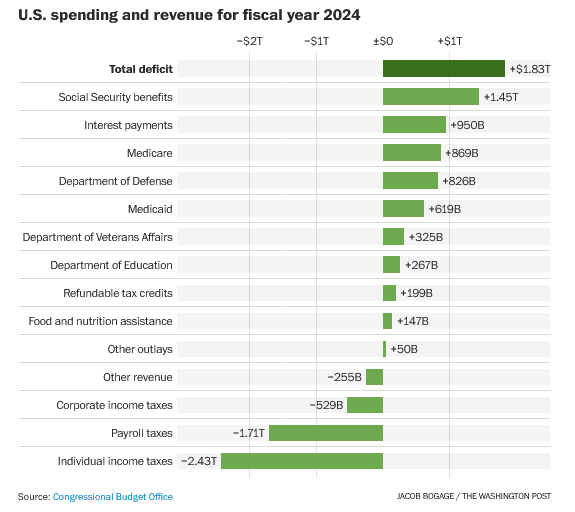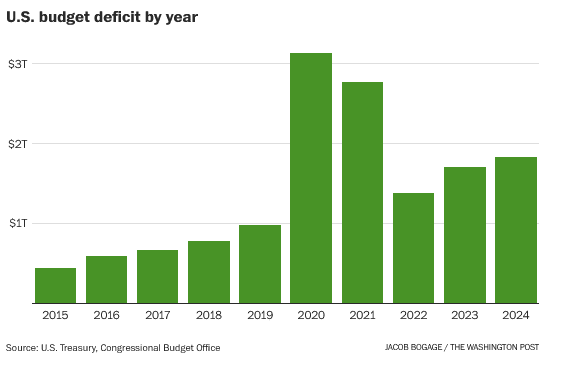Interest payments on the existing national debt cost more than the Pentagon’s budget in the last fiscal year, the Congressional Budget Office reported.
The federal budget deficit swelled to $1.8 trillion in the fiscal year that ended in September, an enormous sum that significantly increases the national debt as Washington barrels toward a potential 2025 showdown over spending and taxes.
The Congressional Budget Office warned in a Tuesday report that interest payments on the debt reached $950 billion, larger than the Pentagon budget.
The next president is likely to face key decisions, along with Congress, about whether and how to tackle the debt and skyrocketing interest costs. Neither former president Donald Trump nor Vice President Kamala Harris has made deficit reduction a key plank of their campaigns for the White House.
As of Friday, the United States had accumulated a public debt of $35.7 trillion. The CBO projected in June that the debt would exceed $50 trillion by the end of this decade. The nation’s debt compared with the size of the overall economy, a key metric of fiscal stability, is projected to exceed its all-time high of 106 percent by 2027.
“A [nearly] $2 trillion deficit is bad news during a recession and war, but completely unprecedented during peace and prosperity,” said Brian Riedl, a senior fellow at the conservative-leaning Manhattan Institute. “The danger is the deficit will only get bigger over the next decade due to retiring baby boomers and interest on the debt.”

While the debt receded as a political issue as the nation spent big to combat the coronavirus pandemic, that is likely to change in the coming year, when major portions of Trump’s 2017 tax cut law expire. Without new legislation, millions of Americans would see a sharp tax increase. But extending the cuts is likely to necessitate massive new borrowing.
Meanwhile, Social Security and Medicare are projected to run out of money in 2035 and 2036, respectively, forcing sharp reductions in benefits without action from lawmakers. And rising interest rates on the debt risk crowding out spending on other vital needs.
The two presidential candidates — and congressional leaders — have far different approaches to handling the country’s finances.
Trump has proposed programs or tax policies that could increase the debt by as much as $15.2 trillion or as little as $1.45 trillion through 2035, according to a nonpartisan estimate released Monday by the Committee for a Responsible Federal Budget (CRFB), a top Washington fiscal watchdog.
He’s proposed massive tariffs on imports that could raise as much as $4.3 trillion over 10 years but would also probably spike consumer inflation and depress economic growth, according to even some of his own economic advisers.
Stephen Moore, an economist at the conservative Heritage Foundation and a Trump economic counselor, has said the former president prioritizes economic growth over spending cuts, reasoning that a growing economy would produce enough tax revenue to outpace inflation.
Trump’s campaign did not respond to a request for comment. Earlier this week, Trump senior adviser Brian Hughes said in a statement that the former president’s plan to control the deficit would “rein in wasteful spending, defeat inflation, reduce the burden of interest costs, and ignite economic growth that fuels federal revenue, so we can make our economy great again.”
But Trump’s plans, and his campaign’s focus on gross domestic product growth, are far from enough to reduce annual deficits, even if the U.S. economy expands well beyond most forecasts.
“You cannot grow your way out of this problem,” said Doug Holtz-Eakin, president of the right-leaning American Action Forum and a former CBO director. “They are arithmetically in the wrong place.”
Harris’s proposals, the CRFB projected, could carry a maximum price tag of $8.1 trillion, or they could be fully paid for with new revenue from targeted tax increases on the wealthiest earners and major corporations, and higher tax rates on capital income.
Harris has pledged to extend the 2017 tax cuts for those making less than $400,000 a year and said earners in the top tax bracket would pay a 39.6 percent rate. But she has not proposed specific new tax rates for filers in between those ranges, making it difficult to assess the budgetary impact of that policy.

A Harris campaign spokesperson said in a statement that Harris as president would commit to reducing the deficit in her budgets.
“One of the things that I’m going to make sure is that the richest among us, who can afford it, pay their fair share in taxes,” Harris said in a “60 Minutes” interview broadcast Monday, when asked about paying for her proposals. “It is not right that teachers and nurses and firefighters are paying a higher tax rate than billionaires and the biggest corporations. And I plan on making that fair.”
A White House spokesman said Republican tax plans would worsen the fiscal crunch.
“While the deficit is lower than it was last year, President Biden believes we need to reduce the deficit further by making the wealthy and large corporations pay their fair share, and by reducing wasteful spending on special interests like Big Pharma,” spokesman Jeremy Edwards said.
Many Democrats say tax cuts — dating to legislation under President George W. Bush in 2001 — have taken too big a bite out of federal revenue, especially in recent years. And the memory of past congressional fiscal battles is haunting some liberal lawmakers. Sen. Elizabeth Warren (D-Mass.) this spring warned Democrats against taking “the coward’s way out” by not raising taxes enough on the wealthy and corporations in the coming tax debate.
“Over the last two decades, we are dealing with the ramifications of about $10 trillion of missing revenue. We’ve had four rounds of massive tax cuts, mostly skewed to the wealthy, none of which were paid for,” Rep. Brendan Boyle (Pa.), the top Democrat on the House Budget Committee, told The Washington Post. “As we get ready for the big once-in-a-decade fight that’s going to happen in 2025 over what tax policy will look like for the next eight to 10 years, we need to be serious about ensuring that we have the proper revenues in order to pay for the size of government we want and the American people expect.”
But the tenor of the presidential campaign has set many budget watchdogs on edge, as both candidates put forward ever-larger spending proposals and embrace extending at least some of the 2017 tax cuts.
After Trump’s running mate, Sen. JD Vance (Ohio), proposed a $5,000 child tax credit — a policy Trump himself has not endorsed — Harris countered with a $6,000 tax credit proposal for parents with newborns. Both candidates have embraced ending taxes on tips: Trump would exempt tipped wages from all taxes; Harris would exempt them only from income taxes and has discussed other policy guardrails.
“It’s a patchwork of targeted fiscal bribes, and it in no way adds up to an overall economic vision, which is really needed at a moment when our economy is changing dramatically,” CRFB President Maya MacGuineas said.
A larger debt burden — fueled by growing annual deficits — could prevent lawmakers from appropriately responding to those changes, experts and policymakers worry.
As the United States is forced to spend more money paying back its lenders, it has less to fund new investments and vital services.
“Debt service is nonnegotiable, so you’ve got to pay that, and you can’t use those funds for any other budgetary priorities,” Holtz-Eakin said.


